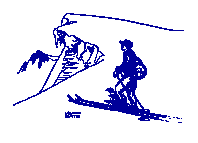
On Saturday morning John showed videos and slides demonstrating avalanche danger, precautions, and rescue. In the afternoon we toured from the Twin Lakes bridge up to Old Mammoth Road, and thence over to the Mammoth Rock area. The tour ended at the head of the Mammoth Meadow. Because the snow was quite difficult (typical early April stuff) some preferred to ski down Old Mammoth Road, where John picked us up in his truck. It was a cold ride back up to Twin Lakes to pick up our cars! After an evening feast we watched some more videos.
We had to watch the videos again the next day because John (who went home Sat night) wanted to comment. One (whose title escapes me) is a Canadian dramatization of two avalanche accidents. In one, an experienced and well-prepared woman randoneé skier is buried, but promptly dug out by her less experienced but beacon-trained friend and some prudent and well-prepared snowmobilers who happen by. In the other, a snowboarder, a skier, and a snowmobiler go to the top of a ridge. The snowmobiler goes down with his video camera, and the skier jumps off a cornice, triggers an avalanche, and is buried along with the snowmobiler below. The horrified snowboarder runs through the debris shouting for his friends, and then encounters the other group who radio for help. A full team appears complete with helicopter, probes and a dog, but the buried people have no beacons and have been buried too long. They are found, dead, by the probe line and the dog, and are airlifted out in body bags. The video shows subsequent psychological decompression, with the poor boarder blaming himself.
This video is an excellent bit of education. John and Allan Bard show it in public training sessions in Mammoth. Some of the people who come are tourists who barely know what an avalanche is, and they go away much more aware and possibly safer. The video not only shows that avalanches are dangerous, it manages to cover almost everything: what sort of terrain is dangerous, travel precautions, the effect of weather and wind on the snowpack, the use of beacons and shovels, snow testing by professionals, the organization and conduct of a rescue, and the probable result of not being prepared, whether one is a skier, boarder, or snowmobiler. It also shows a good slice of mountain life for the benefit of flatlanders. I was impressed. I promise to get the title and update this article.
After this skull session we skied up to Lake Mary and dug a pit where the slope increases towards Twin Lakes. John performed a Rutschblock test. The snow was very stable, having been on the ground for months. The newer top layer, a few inches deep, was not quite so well bonded, as shown by a shovel shear test, but it didn't want to slide when John jumped on it.
John also showed us the Internet resources for weather and avalanche prediction which he uses as a professional avalanche forecaster for the Mammoth area. Some people felt we spent too much time indoors, but I think that John's approach has its merits when combined with more field work in a different setting. Everybody has a different way of doing things.
Participants: David Alabran, Bahram Manahedgi, Tani Barbour, Barb Cohen, Eric Klosterman, Dave Sholle, Dennis Yates.